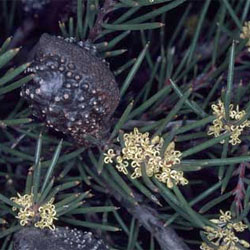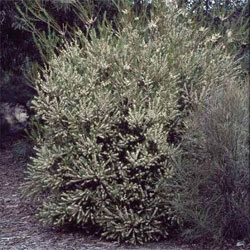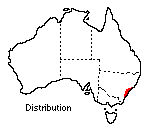Hakea propinqua
 |
 |
a needle bush
There are about 130 species of Hakea, (a genus endemic to Australia) which together form a very valuable group of mostly hardy and often attractive shrubs or small trees.
Hakea propinqua belongs to that group of Hakea species known collectively as 'needle bushes'. The leaves of this group are cylindrical, sharp pointed and are arranged alternately around the stem. The cylindrical shape minimises surface area and hence aids in reducing water loss.
Hakea flowers generally are typical of the Proteaceae family, to which they belong. The flower of H. propinqua has a fused perianth forming a tube 2 - 3 mm long through which the carpel protrudes. The anthers are sessile and located on the perianth lobes. Flowers may either be white or creamy yellow and appear in the axils of the upper leaves.
There appear to be two distinct forms of Hakea propinqua. The Blue Mountains form is low-growing, being only 1.5 - 2 m high, rounded in shape and rather stiff. The older leaves low on the stem are thickened to 2 - 3 mm in diameter and are 4 - 5 cm in length. The newer leaves are shorter and softer and arranged on reddish stems which are quite attractive. The flowers of this form tend to be creamy yellow.
 The
second, the coastal form is a small tree or large shrub with branches close
to the ground, within 30 cm, giving an overall rounded appearance. The red stems
of the outer branches are arching which adds greatly to the beauty of this form.
Specimens at the Australian National Botanic Gardens are almost 4 m high with
a spread of 4 - 4.5 m. The foliage on specimens growing in full sun is quite
dense. In comparison with the small form the leaves are longer (4 - 8 cm), finer
(1 - 1.5 mm in diameter) and less rigid, but retain their sharp-pointed apex.
Plants growing in more shaded areas tend to be less dense and not as rounded
as those which receive more sun. Flowers of the larger form tend to be more
white than cream.
The
second, the coastal form is a small tree or large shrub with branches close
to the ground, within 30 cm, giving an overall rounded appearance. The red stems
of the outer branches are arching which adds greatly to the beauty of this form.
Specimens at the Australian National Botanic Gardens are almost 4 m high with
a spread of 4 - 4.5 m. The foliage on specimens growing in full sun is quite
dense. In comparison with the small form the leaves are longer (4 - 8 cm), finer
(1 - 1.5 mm in diameter) and less rigid, but retain their sharp-pointed apex.
Plants growing in more shaded areas tend to be less dense and not as rounded
as those which receive more sun. Flowers of the larger form tend to be more
white than cream.
Both forms flower through winter into early spring and flowering is at a peak around July and August in Canberra. The woody fruits which distinguish Hakea species from other Proteaceae members are a feature of both forms of H. propinqua. The follicles split open to release two seeds with black membranous wings. The fruits while green are particularly attractive. At this stage the warty protrusions are tipped with cream and separated by deep furrows. Towards the edges of the follicle and in particular at the base and apex the colour deepens and on the extremities is a deep mahogany brown. After some months the fruits dry and become very woody and may remain a feature of the plant for some years. A fully developed follicle on the smaller form may be 3 - 4 cm long and 2 - 3 cm across while on the larger form it may reach dimensions of 5 cm x 4 cm.
The ornament of sharp points on the leaves affords protection for the nests of some smaller species of birds. The Redbrowed Finch and Banded Finch have been observed in the tall form of H. propinqua while wrens such as the Ground Wren or Superb Blue Wren have sought protection in the smaller form.
The tall version of this Hakea in an open sunny position will provide an excellent background screen, but its arching form as opposed to some of the stiffer Hakea forms will allow it to be grown as a specimen if so desired.
Like most Hakeas propagation is by seed.
Hakea propinqua will grow in most soil types and will survive periods of dryness although it is better to avoid this. Periods of extended wetness on poorly drained soils in warmer weather on the other hand may lead to attack by pathogenic root fungi. All in all Hakea propinqua, like many other Hakea species, is a hardy and attractive plant which should succeed in most gardens.
Text byANBG staff (1975)
Name meaning: Hakea propinquaHakea - after Baron Christian Ludwig von Hake, German patron of botany in the 18th century; propinqua - feminine form of propinquus, meaning near
or related (the reason for the use of this epithet is obscure). |
![An Australian Government Initiative [logo]](/images/austgovt_brown_90px.gif)

